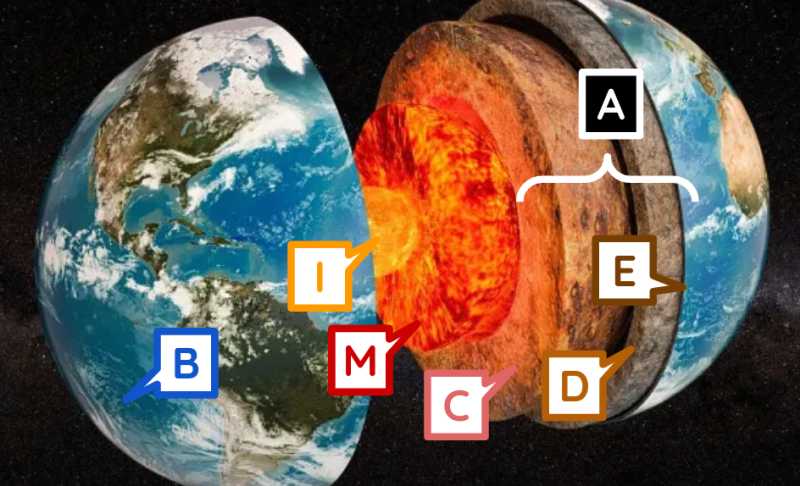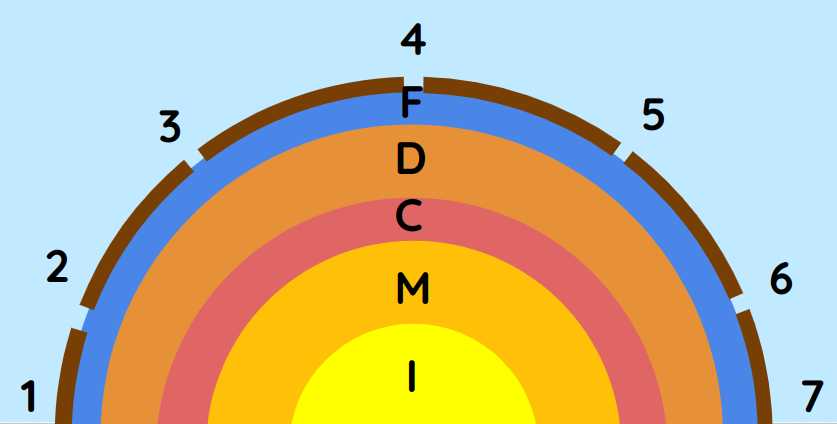The Mountains, Seas, and the Air
Table of Contents
40. How Body D was reduced in size, and left some space between itself and Body E
During the daytime and summer, the Sun decompresses half of Body D with its light and heat.
All the matter of this half could not be contained between the 2 neighboring bodies C and E, which were solid.
- Nor could
CandEexpel them.

I is the innter core, M is the outer core, C is the lower mantle, D is the upper mantle, E is the crust,Hence, most these particles ascended through the pores of body E towards B.
Later, during the nighttime and winter, this decompression ceases due to gravity.
- And so these particles descend again.
However, there were many reasons why the earth-aether particles that exited Body D could not all return to it.
They left with greater force than they returned because the force of expansion from heat is greater than gravity.
Therefore, many found their way through the narrow passages of body E to ascend.
- But they found no path to return, and so they stayed on its surface.
Some of the ascending particles were impacted in the passages. This made them unable to ascend further, blocking the paths for the others descending.
The motion of the air-aether globules pushed out of body D those that were lighter and had a smoother and rounder shape.
- These offered themselves to ascend towards
EandB.
These met the particles of E and B and often changed their shapes to adhere to them or at least cease to be suitable to return towards D.
Consequently, after many years, a large part of body D was consumed.
- The only particles that remained were the flexible and inflexible ones.
Body E became dense and thick because almost all the particles that left D either:
- made it denser by impacting its pores or
- collided with the particles of body
Band so were changed and annexed toE, returning to it and increasing its thickness.
Finally, a considerable space F was left between D and E.
- This could only be filled by the material from which body
Bwas formed.

The extremely fine particles of body B easily passed through the passages of body E, left vacant by others a little denser coming out of D.
41. How many cracks were formed in body E.
Body E is heavier and denser than F and possibly even D. But it remained suspended over D and F for a while due to its hardness.
When it first formed, it had many passages excavated to the size of body D.
Its surface then bore the weight. And so it inevitably provided passage to the particles moved by the heat during the day, ascending towards B, and descending again at night.
These particles filled these passages always following each other.
Later, with the decrease in the mass of body D, not all its particles occupied the passages of body E.
- Smaller particles from
Btook their place.
These did not sufficiently fill the passages of body E.
Since a vacuum is not allowed in nature, the air-aether, which alone can fill all the tiny spaces around the earth-aether particles, rushed in.
It changed their shapes and drove some of them apart so that, in doing so, others nearby became narrower.
Consequently, with some parts of body E separated from each other, cracks formed.
- These grew larger over time.
This is the same as the cracks opening in the earth during the summer when it dries in the Sun and yawns wider the longer the dryness persists.
42. How the cracks broke into various parts
The many such cracks in body E continuously expand.
- Its parts eventually adhered so little to each other that it could no longer sustain the arch-like form between
FandB. - Consequently, it broke entirely, falling onto the surface of body
Cdue to its gravity.
This surface was not wide enough to accommodate all its fragments adjacent to each other.
This is caused some of them to incline towards one side and lean on each other while maintaining their previous positions.
For example, body E had significant cracks in positions 1, 2, 3, 4, 5, 6, 7.
- The two fragments
2, 3and6, 7started to fall slightly before the others.
The ends of the other four fragments, 2, 3, 5, and 6, before the opposite 1, 4, and V.
Likewise, the end 5 of fragment 4-5 fell somewhat earlier than the end V of fragment V-6.
They must already be arranged in this way above the surface of body C, just as depicted here.
In other words, fragments 2, 3 and 6, 7 are closely connected to body C, while the other four are reclined to the side, leaning on each other, and so on.
43. How Body D partly ascended above the Body E and partly remained below.
Body D is fluid and less dense than the fragments of Body E. So it occupies all the lower cavities left by these fragments and their cracks and passages, and also rises above them as much as it can.
